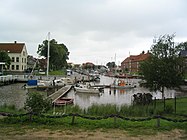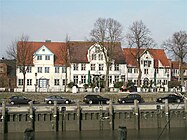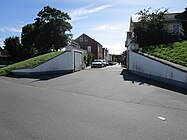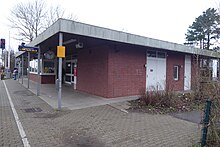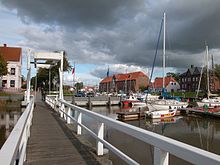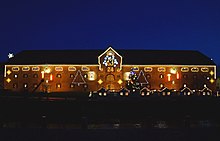Toenning
| coat of arms | Germany map | |
|---|---|---|

|
Coordinates: 54 ° 19 ′ N , 8 ° 57 ′ E |
|
| Basic data | ||
| State : | Schleswig-Holstein | |
| Circle : | North Friesland | |
| Management Community : | Office Eiderstedt | |
| Height : | 2 m above sea level NHN | |
| Area : | 44.41 km 2 | |
| Residents: | 4984 (Dec. 31, 2019) | |
| Population density : | 112 inhabitants per km 2 | |
| Postal code : | 25832 | |
| Primaries : | 04861, 04862 | |
| License plate : | NF | |
| Community key : | 01 0 54 138 | |
| LOCODE : | DE TOE | |
City administration address : |
Am Markt 1 25832 Tönning |
|
| Website : | ||
| Mayoress : | Dorothe Klömmer ( CDU ) | |
| Location of the city of Tönning in the district of North Friesland | ||
Tönning ( Danish : Tønning , Frisian : Taning . Low German : Tönn , Tönnen and Tünn ) is a town and a spa and climatic health resort with around 5000 inhabitants in the district of North Friesland , Schleswig-Holstein . Located on the Eider , near its confluence with the North Sea near the Eider Barrage , the city has a harbor that was until the end of the 19th century is of great importance. The districts of Kating , Katingsiel , Olversum and Groß Olversum belong to Tönning .
geography
Geographical location
The urban area of Tönning is located on the northern bank of the Eider River on the Eiderstedt peninsula. South of the town the river widens into the funnel- shaped mouth area of Purrenstroms .
Neighboring communities
The urban area is bordered by the following municipal areas:
| Katharinenheerd | Kotzenbüll | Oldens word |
|
World , Vollerwiek |

|
|
|
Karolinenkoog , Wesselburenerkoog (Dithmarschen district) |
geology
The municipal area is assigned to the landscape area of the Schleswig-Holstein marshes of the greater North German lowlands and forms a part of the Eiderstedt peninsula (historically also called Thynning in Danish ). This area was first surrounded by a 1.5 meter high summer dike in the 12th century . According to its age, this area is mostly classified as Kleimarsch today .
Following the down insulation of Eiderästuars the construction of the Eider Barrage were parts of the previously north bordering on Purrenstrom foreshore - and Watts areas of the so-called Katinger Watts dikes and also added to the municipality of Tonning. Large areas among them are now a Natura 2000 protected area as nature conservation areas and are exempt from further economic interventions. In the Katinger Watt there is a 495 hectare forest. It is the only larger forest area in this landscape area in Schleswig-Holstein.
In 1974 the municipal area was finally enlarged again by the incorporation of Kating , Katingsiel , Olversum and Groß-Olversum . These municipal areas are also part of the aforementioned original area of the Eiderstedter Peninsula.
history
Early years: Tönning and Eiderstedt

The Tönningharde ( Tunnighen haeret , cf. Harde ) was first mentioned in 1187. She was part of the Uthlande . The future St. Laurentius Church was founded as early as 1186 . This year, Bishop Waldemar asked the place to pay tithes to the church. In 1414 the Dithmarscher Tönning burned down.
Between 1580 and 1583, the Tönninger Castle was built under Duke Adolf von Schleswig-Holstein-Gottorf . Adolf was the first duke of the newly founded duchy of Schleswig-Holstein-Gottorf; as part of this, he built the castle in front of Husum and a little later the Tönninger castle .
Tönning's heyday as a city began when immigrants from the Netherlands created a strong economic boom in the three countries . Above all, they introduced cheese production on a large scale; Tönning became the most important port of export. In the record year 1610, three million pounds of cheese went through the Tönninger port. The average from 1607 to 1624 was 2.7 million pounds annually.
The small town of Tönning ( town charter since 1590) was the place of jurisdiction for the eastern part of Eiderstedt, from 1630 the Eiderstedt regional assembly also met here. Duke Adolf von Schleswig-Holstein-Gottdorf expanded the traffic routes. While Tönning was previously only accessible from the hinterland via Kleiwege , which became impassable when wet, he built smaller canals to Garding ( southern boat trip from Garding to Katingsiel with a branch to Tönning) and to Tetenbüll ( northern boat trip ) , while at the same time better drainage techniques in the area Agriculture yields improved. In the 17th century, 60,000 pounds of wheat passed through the port annually ; there were also large numbers of live animals, meat and wool.
The port was dug in its current form in 1613. It provided a berth for the ships that brought Eiderstedt's agricultural products to all of Western Europe.
1644–1714: Fortress of the Schleswig-Holstein-Gottorfer
The Burchardi flood in 1634 destroyed 15 buildings and killed 34 people. But by 1644 the city had already recovered. Tönning was a fortress town from 1644 to 1675 and again from 1692 to 1714 . After the experiences of the Thirty Years War , the Gottorf Duke Friedrich III. Even while the war was still going on after Tönning and began to develop the city into a fortress. Using 30 tons of gold, regular bastions and several "bomb-proof" vaults were built and the fortress was provided with three gates, the Easter, North and West Gate. In the south, the Eiderstrom formed both a gate and a defense. Together with Rödemiser Schanze in the north, Tielener, Sorge and Holmer Schanze in the east and Hamhus in the south, an extensive fortress was created. Both the duchy and the residents of Eiderstedt and the allied Swedish king paid for the construction of the fortress. The actual seat of the Gottorf family in Gottorf was along the great military route through Schleswig-Holstein and was therefore at great risk in any armed conflict. The first plans to build an alternative residence on the island of Strand came to nothing when it sank into the sea at the Second Groten Mandränke .
The Danish troops of King Friedrich III. besieged the fortress in 1659 as part of another war with the Gottorfern, but could not conquer it. In 1675, however, the king succeeded in temporarily driving the Duke of Gottorf and son of Friedrich Christian Albrecht out of his duchy and becoming ruler of Schleswig and Holstein. In the same year he razed the fortress.
After Christian Albrecht got his duchy back with the help of the German emperor and European allies, he rebuilt the fortress in 1692. He had the number of bastions increased from originally nine to eleven and hired experienced Swedish fortress builders under the direction of Zacharias Wolf , who later also became the fortress commander. He built the armory in 1709/10.
In the Great Northern War between Sweden and Gottorf on the one hand and Denmark, Russia, Poland and Saxony on the other, the decisive battles took place in the Gottorf area in Tönning. In 1700 the Danish King Friedrich IV marched into the Duchy of Holstein-Gottorf with 14,000 men. On April 22, 1700, the Tönning fortress was enclosed and besieged. During this time it was hit by several thousand artillery shells, which caused great devastation, but could be held until the invasion of Holstein, allied with the Gottorfs, freed it on June 2, 1700.
As a result, the fortress was reinforced again with additional forward bastions, which made the influence of the French fortress builder Vauban visible with the refined construction technology .
In February 1713, Zacharias Wolf took the fleeing Swedish troops from Magnus Stenbock into the fortress, who sought protection from the troops of the Danes, Russians and Saxons after they had defeated the Danes on December 20, 1712 at the Battle of Gadebusch . In addition to the regular crew of 1,500 men, 11,000 Swedes moved into the city with 1,000 horses and other attachments. A total of 22,000 people are said to have been on the square kilometer of the completely unprepared fortress at this time. Since there were hardly any supplies for so many people and epidemics quickly broke out, Count Stenbock surrendered relatively quickly in May 1713 with the Swedish army, which left the fortress. The Tönning fortress was still besieged as Denmark and Gottorf were still at war. This time there was no major damage as in the first siege due to the lack of artillery fire. It was not until February 1714 that the supplies for the much smaller regular population ran out, so that Zacharias Wolf gave up the fortress. Gottorf had no military chance against the Danish king. As a result of the war, he became Duke of the entire Duchy of Schleswig and limited the influence of the Gottorfer on the Holstein parts .
The Danish king then had the fortress finally razed and the Tönningen Castle demolished in the process.
Upswing through the Eider Canal, bloom during the continental blockade
The port and shipping include shipyards or Lastadien, as they were also called at that time. From 1740 H. Dreyer built wooden ships in Tönning, which until recently existed as Dawartz shipyard . J. Lexow founded a small shipyard in 1801, which was closed in 1806 as a result of the Napoleonic Wars. The shipyard founded by Schömer & Jensen in 1890 was continued as the Eiderwerft in 1904 and by 1909 over 90 newbuildings were built for shipowners from Tönning, Husum, Hamburg and for authorities. From 1916, under the name Tönninger Schiffswerft & Maschinenfabrik and as a plant of the Norddeutsche Union Werke shipyard group, another 20 ships and two floating docks were delivered. The shipyard was closed in 1923 and demolished in 1927. In 1905 Hermann Fack, who came from the Fack shipbuilding family in Itzehoe , founded a shipyard in Tönning. Ewer, galeasses, barges and fishing cutters were built here and delivered to shipowners in Schleswig-Holstein until 1910.
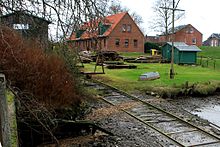
A former warehouse, the listed large packing house from 1783, reminds of the time of the Eider Canal , which was opened on October 18, 1784 with a test drive by the sailor Rendsburg . The canal built between Rendsburg and Kiel connected the North Sea with the Baltic Sea via the Eider for the first time via a connection that was passable for seagoing ships. As an inland port in front of the open North Sea, Tönning benefited from ships that docked here and equipped themselves for the further voyage through the North Sea or through the Canal and the Baltic Sea. Immediately following the construction of the canal, a tannery , a Reepschlägerei, starch factories, two breweries and a brick factory were built. The Tönningen dealers themselves did not own any ships, but were successful ship buyers and brokers.
The city experienced a brief boom during the Elbe blockade by the British and the subsequent continental blockade by Napoleon. Tönning was in neutral Denmark and was therefore not affected by the continental lock. Between 1803 and 1807 all traffic destined for Hamburg ended up in Tönning, from where the merchants transported it overland. From 1805 the Dutch East India Company also used the canal and the port for their transports to Copenhagen and the Baltic Sea region. The city itself had to prepare for this onslaught. P. A. Nemnich described the city in 1805: “Everything was missing. One did not want to use large costs for a presumed moment. The recipients of the goods in Hamburg shouted loudly about the disorder, neglect and spoilage of the goods, embezzlement and deterioration of the transport. ”The population in Tönning tripled during this time.
Another upswing arose in 1854 with the construction of the Flensburg – Tönning railway line , on which cattle were transported to England for loading and English coal was taken in the opposite direction. After brief slumps in 1886, cattle exports ended for good because of the foot and mouth disease .
Merchants from all over Europe came to Tönning; For a few years the port became one of the most important ports on the continental European North Sea coast. The packing house, which was built together with the Eider Canal, now houses, among other things, the extensive historical collection of the Society for Tönninger City History . In 1867 a district court was established in Tönning, which existed until 1974.
- The old port today
The Schifferhaus from 1625 is today a school camp and meeting house of the Südschleswigschen Verein .
A staircase (dike passage) at the port
Back to the periphery: after the Kiel Canal
Tönning's position as an important port of passage ended when the Kaiser Wilhelm Canal (today: Kiel Canal ) was opened in 1895 , which led ships to the North Sea via the Elbe to the south and no longer via the Eider.
With the completion of the Eider Barrage in 1972, the historic port of Tönning lost its importance as a fishing port, as almost all fish and shrimp cutters were moved there. The fishing port there is also located in the Tönninger urban area. While the role of the city port declined more and more, tourism established itself as the city's new economic pillar.
Incorporations
On January 1, 1974, the former parishes of Kating and parish Tönning were incorporated.
Incorporated villages:
- Kating
- Katingsiel
- Olversum
- Great Olversum
politics
Since January 1, 2010, Tönning has formed an administrative partnership with the Eiderstedt office , which partially carries out the administrative business for the city.
City council
| CDU | SPD | SSW | AWT * | total | |
| 2018 ** | 5 | 5 | 3 | 4th | 17 seats |
| 2013 | 5 | 5 | 4th | 3 | 17 seats |
| 2008 | 7th | 5 | 4th | 4th | 20 seats |
* General voter community Tönning ** Local election on May 6, 2018
Due to the decline in the number of residents, only 17 council seats have been available since the 2013 election.
Jan Dieckmann (SPD) has been the mayor of the city of Tönning since December 2014.
mayor
- 1590: Peter Keen
- from 1590: Johann Gerritz
- from 1615: Gerrit Dircks
- from 1619: Jochim Keens
- from 1621: Johann Jansen
- 1633: Rudolf Lange
- from 1633: Wilhelm Schomacker
- from 1647: Hinrich Meldert
- from 1650: Balzert Kostelitz
- from 1652: Peter Jansen Becker
- from 1654: Wilhelm Schomacker
- from 1660: Dietrich Kistener
- 1678: Hinrich van Meldert
- from 1678: Friedrich Gerbrandt Burgundia
- from 1688: Claus Reyer
- from 1694: Friedrich Jürgens
- from 1697: Mummius Lüddens
- from 1707: Jacob Siebink
- from 1719: Adolf Thomsen
- from 1721: Iven Jakobs
- from 1722: August Friedrich Zelles
- from 1725: Wilhelm Siebink
- from 1733: Georg Wilhelm Mercatus
- from 1738: Ernst Wulffhagen
- from 1759: Peter Gerckens
- from 1762: Jürgen Backens
- from 1765: Johann Wolfhagen
- from 1766: Hinrich Fock
- from 1771: Thomas Sibbers
- from 1772: Jacob August Sievertz
- from 1777: Jürgen Jürgens
- from 1788: Diedrich Bundies
- from 1790: Hans Cordt Schmidt
- 1800–1807: Johann Andreas Lesser
- 1807-1821: Peter Thomsen
- 1822–1832: Friedrich August Adler
- 1833–1838: Hans Christian Detlef Müller
- 1839–1843: Friedrich Wolfhagen
- 1844–1847: Dähnhardt
- 1847-1850: Cramer
- 1850-1852: from Dubell
- 1852-1856: Johannsen
- 1856-1857: Helms
- 1857–1861: von Schöller
- 1862-1864: Goos
- 1864-1865: Ove Becker
- 1865–1867: Charter user
- 1867–1868: Hansen
- 1868–1869: Scholz
- 1869–1898: David Samman
- 1899–1911: Erasmus Ehrich
- 1911–1914: Paul Steffen
- 1914–1921: Richard Brandenburg
- 1921–1926: Walter Schlimm
- 1926–1933: Heinrich Altmann
- 1934–1937: Herbert Meußer
- 1937–1945: Friedrich Gerlach
- 1945–1946: Anton Schömer
- 1946–1960: Heinrich Christensen
- 1960–1978: Rolf Pankuweit ( CDU )
- 1978–1997: Gerhard Bittner
- 1997–2014: Frank Haß
- since 2015: Dorothe Klömmer
coat of arms
The coat of arms was approved on October 22, 1953.
Blazon : "In red on blue-silver waves in the base of the shield, a lying golden barrel on which stands a black armored silver swan with raised wings."
The city has a coat of arms that goes back to historical models. Because of the linguistic consonance (Tonne and Tönning are both called "Tünn" in Low German), the bin is supposed to put the name of the city in the picture in a popular way. The coat of arms is therefore the classic example of a "talking" symbol. The waves indicate the location at the mouth of the Eider . According to legend, Tönning was founded on the spot where a swan standing on a barrel was driven ashore. The swan and barrel in the coat of arms are a reminder of this founding myth. "Tunnighen" is mentioned for the first time in 1187 and developed into a certain importance through shipping, trade and fishing. In 1590 the place was elevated to a city. In this context, the large city seal was created, which showed a ship floating on waves, the mast of which was covered by a shield with two lions and a barrel: The Schleswig lions and the Eiderstedter ship, i.e. sovereign and landscape, represent Tönning's scope for political decision-making by the bin, a. This seal image, which later lacked the waves, was probably mainly used as a court seal since the middle of the 17th century. At the same time, a small city seal came into use. It only showed an upright barrel. A third seal image with the swan standing on the bin was added, presumably in the 18th century. This program of figures, apparently regarded as the "real" Tönninger icon, was carried on the flags of Tönninger ships around 1800. The large ship's seal from the 16th century was abolished in the 19th century and the coat of arms that is valid today was recognized as the city's official landmark. The official statement in 1953 confirmed this decision.
The coat of arms was designed by the Brunsbüttel heraldist Willy "Horsa" Lippert .
Twin cities
Tönning's twin town was Skærbæk Municipality in Denmark until the end of 2006 . The town twinning was dissolved by restructuring the administrative units in Denmark.
- In October 2013 a new partnership was concluded with the French city of Lacanau . Lacanau is located in the Gironde department , about 45 kilometers west of Bordeaux .
- Another partnership was concluded in December 2013 with the Danish island community Fanø . Fanø is the northernmost of the Danish Wadden Sea Islands and is about 30 kilometers north of Sylt . The municipality is mainly focused on tourism.
Economy and Infrastructure
traffic
Rail transport
The city is connected to the German rail network via the Husum – Bad St. Peter-Ording line. On the single-track route, there is only local rail passenger transport . Operation is currently by the company DB Regio in every hour after the later integrated predecessor companies in a tendering project DB Regio Schleswig-Holstein had won the bid was made for the year 2011 until the 2,021th The Kating stop is also located within the municipality as a request stop . This is about 1–1.5 kilometers north of the village of the same name .
The predecessor of this line was the Flensburg – Husum – Tönning line built by the English building consortium Peto, Brassey and Betts under Samuel Morton Peto . The original goal was to transport cattle from the Danish part of Schleswig to England and import coal from there. After the annexation of Schleswig by Prussia in 1866, the line was rebuilt, and since Husum was connected to the Marschbahn , its function has changed to an extensive feeder line in local public transport .
Private transport
The Federal Highway 5 runs since 1975 on a folding bridge over the eider ; it connects Eiderstedt with Dithmarschen. Since the Eider Barrage was built in 1973, it has been the closest possibility to cross the Eider; previously it was the bridge near Friedrichstadt .
Port facilities
Located at the mouth of the Eider, the city was given a port early on. The historic harbor basin on the edge of Tönning's city center quickly became the economic lifeline of the city and the surrounding area. Today it is mostly used as a pleasure boat and leisure port.
The economically intensive working farms are now at the quay Eiderkaje or at the port outer dike on Eidersperrwerk settled.
Industry, craft, trade and commerce
Three industrial companies for the production of pump and system technology, traffic safety devices as well as gate drives and barrier systems as well as 51 craft businesses are located in Tönning. In 2013 there were 198 commercial and commercial enterprises in the city, of which 65 were retail and 6 wholesaling and 43 were catering and hotel business.
tourism
In 1818 private investors built a bathing establishment on the Eider . It was the first attempt to import the emerging trend on the west coast of Schleswig-Holstein. But the bath was not successful because of “the sloping and muddy bank of the Eider”; Wyk auf Föhr can thus claim the fame of the first Schleswig-Holstein seaside resort.
Today tourists come mainly for the picturesque harbor. But the green beach on the Eider is still a public bathing beach with wicker beach chairs and bathing operations are monitored by the German Life Saving Society ( DLRG ). The Multimar Wattforum , which opened for Expo 2000 , is the most important exhibition on the Schleswig-Holstein Wadden Sea National Park . Tönning is also on the route of the Wikinger-Friesen-Weg theme cycle path .
Public facilities
Tönning is the seat of the Tönning Waterways and Shipping Office , whose area of responsibility is the west coast of Schleswig-Holstein (from the Danish border to the mouth of the Elbe). The lighthouses of the administrative district are controlled and maintained from Tönning and the North Sea shipping routes are kept operationally safe and re-marked with appropriately equipped navigation signs (fairway buoys ); This is why the many multi-colored sea marks are stored at the depot of the Waterways and Shipping Office (WSA) at the port . Furthermore, the WSA Tönning is responsible for the operation and maintenance of the federal waterways Eider and Sorge .
Tönning is also the seat of the Schleswig-Holstein Wadden Sea National Park Office . The National Park Service is also located there, which is legally independent but closely integrated into the National Park administration.
The clinic in Tönning was closed at the end of 2016.
education
There are the following general education schools in Tönning:
- School at Ostertor (elementary school with support center part), Hochsteg (177 students in 8 classes / 107 FöZ-supervised)
- Eider-Treene-Schule (community school with upper school level / with branch in Friedrichstadt), Badallee (843 students in 37 classes)
- Uffe-Schule (elementary school with community school / provider: Danish School Association), Herzog-Philipp-Allee (66 students in 4 classes)
Student numbers from the school year 2018/2019.
The educational offer is supplemented by the local adult education center and the Tönning city library. Tonning once in the month of bookmobile the Danish Library approached.
Culture
In the list of cultural monuments in Tonning entered in the list of monuments of Schleswig-Holstein are cultural monuments .
Cityscape and buildings
- The port with its historical structure is characteristic of the cityscape.
- In the old town there are still gabled houses from the 17th and 18th centuries that show Dutch influence.
- The Protestant St. Laurentius Church stands on the market square , the north wall of which dates from the 12th century. The baroque spire was built between 1703 and 1706. The pulpit, carved by H. Röhlke in 1703, is a gift from the family of the painter Jürgen Ovens and shows him together with the Holy Family on the epitaph .
- The market fountain is one of the few art fountains in Schleswig-Holstein.
- The Tönninger Castle has been completely destroyed, only the castle park has been preserved.
- On its 60th birthday in 2016, the Round Table Tönning , a non-profit beautification association, gave the city the so-called seal statue . This was installed at the port opposite the packing house and shows a family of seals cast in bronze in their original size.
Regular events
- On the second weekend before Easter, an international Easter egg market takes place on Saturdays and Sundays in the historic packing house at the port.
- On the third Sunday in August, the traditional “peer market” (horse market) takes place in the castle park. The evening before there are fireworks at the port.
- Every year on the Advent weekends there is a Christmas market on two floors in the old packing house at the historic harbor. The facade of the packing house has been the longest Advent calendar in the world over its entire height and over a length of 77.5 meters since 1997 in the entire pre-Christmas period .
Others
In the 1980s, Tönning formed the backdrop for the four-part mini-series Pogo 1104 on ARD . The comedy tells how three young men in Northern Germany install a pirate transmitter on a ship, the Pogo, and operate it from the North Sea.
Personalities
Honorary citizen
- Friedrich Wilhelm Selck (1821–1911), councilor, honorary citizen since 1899
- Friedrich von Esmarch (1823–1908), German doctor and the founder of the civilian Samaritan system in Germany, honorary citizen since 1897. A statue in the palace gardens commemorates him.
- Jacob Alberts (1860–1941), Hallig painter, honorary citizen since 1931
- Paul Dölz (1887–1975), honorary citizen since 1967
sons and daughters of the town
- Jürgen Ovens (1623–1678), painter, portraitist
- Caeso Gramm (1640–1673), professor of natural history and Greek at the Christian Albrechts University in Kiel
- Johann Friedrich Alberti (1642–1710), composer, organist
- Friedrich Wolfhagen (1777–1846), lawyer and mayor of Tönning, father of Marie Norden
- Ove Wilhelm Michelsen (1800–1880), Rear Admiral and Minister
- Johannes Gaye (1804–1840), art historian
- Marie Norden (1812–1878), actually Friederike Wolfhagen, writer
- Wilhelm Heinrich Koopmann (1814–1871), Lutheran theologian, bishop for Holstein
- Karl Gustav Haase (1840–1908), German physician.
- Claus Hans (1900–1977), politician (NSDAP)
- Kurt Thomas (1904–1973), composer, music teacher and choir director
- Jürgen Gosch (* 1941), entrepreneur
- Ernst-Erich Stender (* 1944), church music director and organist
- Thomas Dahl (* 1964), church music director and organist
- Annette Klussmann-Kolb (* 1969), biologist and university lecturer
- Katrine Hoop (* 1970), Danish-German activist and author
Connected to Tönning
- Hinrich Brarens (1751–1826), captain, pilot inspector and navigation instructor, died in Tönning. He wrote the first German-language textbook on shipping.
- Ferdinand von Mueller (1825–1896), German-Australian botanist and geographer
- Toni Jensen (1891–1970), politician (SPD), grew up in Tönning.
- Dirk Römmer (* 1943), pastor, author, television presenter and chairman of the Institute for Low German , lives in Tönning.
literature
- Philipp Andreas Nemnich: Tönning. Description of the place in mercantile terms . Müller, Scholtz, Hamburg / Tönning 1805.
- Friedrich Wolfhagen: Descriptions of the city of Tönning together with memories covering the first quarter of this century. Description of the town of Tönning, together with the conditions of the same, before, during and after the Elbe and Eider locks . Bade and Fischer, Friedrichstadt 1838.
- 350 years of the city of Tönning. October 12, 1590-12. October 1940 . Toenning 1940.
- Tönning from A to Z . West Coast Publishing House, St. Peter-Ording 1977.
- Bulletin of the Society for Tönninger City History . 1981 ff. Issue 1 ff.
- Tönning through the ages - citizens write about their city . Edited by the city of Tönning. Husum Druck- und Verlagsgesellschaft, 1990, ISBN 3-88042-498-5 .
- Toenning . In: Klaus-Joachim Lorenzen-Schmidt, Ortwin Pele (Hrsg.): Schleswig-Holstein Lexikon . Wachholtz, Neumünster 2006, ISBN 3-529-02441-4 , pp. 582-583.
Web links
Individual evidence
- ↑ North Statistics Office - Population of the municipalities in Schleswig-Holstein 4th quarter 2019 (XLSX file) (update based on the 2011 census) ( help on this ).
- ↑ see section of the historical map by Johannes Steenstrup Kort over Danmark Ældste Inddeling
- ↑ Kunz, Harry: The kings of North Friesland. 2nd edition, Bräist / Bredstedt, Nordfriisk Instituut, 1999, ISBN 3-88007-251-5 , p. 85
- ^ Leaflet of the Landesforsten Schleswig-Holstein: Wald im Watt - A concept for the Katinger Watt.
- ↑ C. von Wimpfen: History and conditions of the Duchy of Schleswig or South Jutland: from the oldest times to the present . Baurmeister & Comp., 1839, p. 19th f . ( Google Books (full view) [accessed May 25, 2010]).
- ↑ a b Wilhelm Sager: Armies between the seas - Army and war history of Schleswig-Holstein. Husum printing and publishing company. Husum. 2003. ISBN 3-89876-113-4 . Pages 42-43.
- ^ Christiane Witte: The Tönninger Packhaus - 225 years old . Self-published, Tönning 2008, p. 2 f.
- ↑ Quoted from Gerd Stolz: The old Eider Canal - Schleswig Holstein Canal . 4th edition. Boyens & Co., Heide in Holstein 1989, p. 63
- ↑ http://www.kohlus.de/toenning/tgdt13/k1848.html German-Danish War 1848–1850
- ^ Sydslesvigsk Forening
- ^ Federal Statistical Office (ed.): Historical municipality directory for the Federal Republic of Germany. Name, border and key number changes in municipalities, counties and administrative districts from May 27, 1970 to December 31, 1982 . W. Kohlhammer, Stuttgart / Mainz 1983, ISBN 3-17-003263-1 , p. 182 .
- ↑ Schleswig-Holstein's municipal coat of arms
- ↑ Tönning through the ages. Husum Druck- und Verlagsgesellschaft, 1990, p. 166
- ^ Economic information Tönning ( Memento from September 6, 2014 in the Internet Archive )
- ^ Dirk Legler: The organization of German national park administrations . Baden-Baden, Nomos 2006, ISBN 3-8329-1978-3 , p. 209
- ↑ Nordfriesland passes a referendum on clinics. shz.de, accessed on February 12, 2017
- ↑ Statistical Office for Hamburg and Schleswig-Holstein: Directory of general education schools in Schleswig-Holstein 2018/2019
- ↑ Tönning City Library
- ^ Dansk Centralbibliotek for Sydslesvig: Bogbus Tur 22
- ↑ Guinness Book of Records







